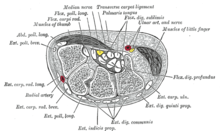Tinel's sign
| Tinel's sign | |
|---|---|
 | |
| Transverse section across the wrist and digits. (The median nerve is the yellow dot near the center. The carpal tunnel is not labeled, but the circular structure surrounding the median nerve is visible.) | |
| Specialty | Neurology, Plastic surgery |
| Differential diagnosis | Peripheral neuropathy, Radiculopathy, Plexopathy |
Tinel's sign (also Hoffmann-Tinel sign) is a way to detect irritated nerves. It is performed by lightly tapping (percussing) over the nerve to elicit a sensation of tingling or "pins and needles" in the distribution of the nerve.[1][2] Percussion is usually performed moving distal to proximal.[2] It is named after Jules Tinel.[3][4][5]
It is a potential sign of carpal tunnel syndrome,
History
Tinel's sign takes its name from French neurologist Jules Tinel (1879–1952), who wrote about it in a journal article published in October 1915.[3][4][5] German neurologist Paul Hoffmann independently also published an article on the sign six months earlier, in March 1915.[10][11] Previously, in 1909, Trotter and Davies published their findings that sensations elicited distal to the point of nerve resection are referred to the area or point of nerve resection; however they "failed to comment on the clinical relevance of their observation."[11]
See also
- Hoffmann's sign
- Phalen maneuver
References
- ISBN 978-0-323-09138-1, retrieved 2020-10-29
- ^ ISBN 978-1-4377-0575-1, retrieved 2020-10-29
- ^ a b Tinel, J. (1978) The "tingling sign" in peripheral nerve lesions (Translated by EB Kaplan). In: M. Spinner M (Ed.), Injuries to the Ma jor Branches of Peripheral Nerves of the Forearm. (2nd ed.) (pp 8–13). Philadelphia: WD Saunders Co
- ^ a b Tinel, J. (1915) Le signe du fourmillement dans les lésions des nerfs périphériques. Presse médicale, 47, 388–389
- ^ a b Tinel, J., Nerve wounds. London: Baillère, Tindall and Cox, 1917
- ISBN 978-1-4377-0906-3, retrieved 2020-10-29
- ISBN 978-1-4377-0906-3, retrieved 2020-10-29
- ISBN 978-0-323-06504-7, retrieved 2020-10-29
- PMID 30907815.
- PMID 14829100. Retrieved January 24, 2021.
The very same phenomenon, however, had been described by Paul Hoffmann in a German medical periodical in the issue of March 28 of the same year. The Germans, therefore, speak of the Hoffmann-Tinel sign.
- ^ PMID 16718952.
Dr. Paul Hoffmann described the sign in March of 1915 in On a Method of Evaluating the Success of a Nerve Suture. Several months later in October 1915, Dr. Jules Tinel published his work on the sign in The Sign of Tingling in Lesions of Peripheral Nerves.
External links
- synd/3740 at Who Named It?
